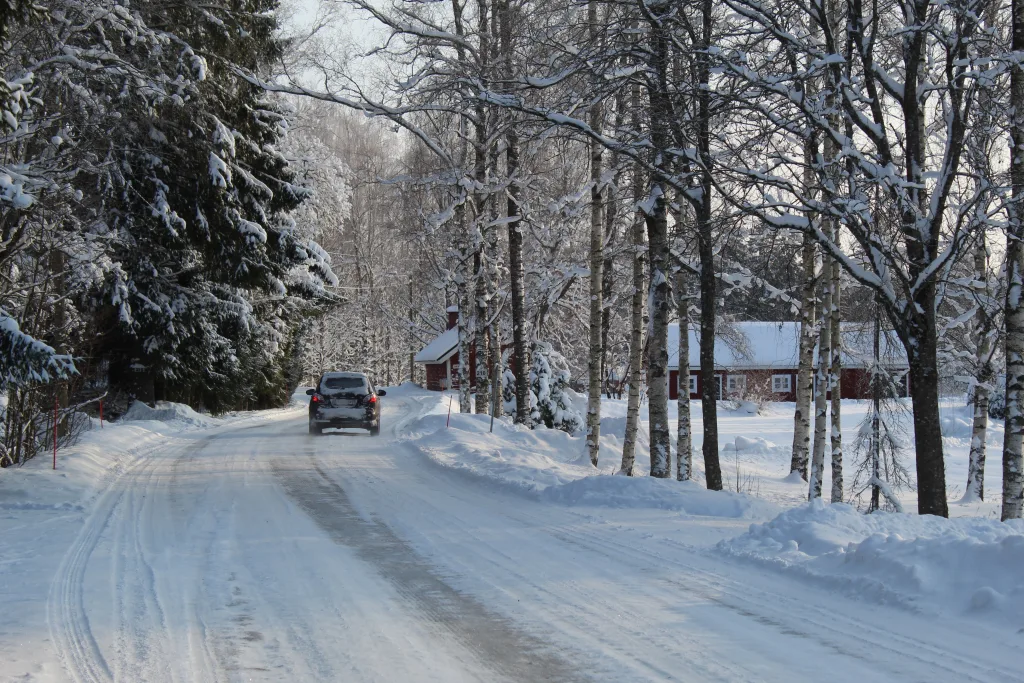Roads can be treacherous when it comes to driving, especially during adverse weather conditions. It is crucial for drivers to understand the factors that contribute to a road’s slipperiness in order to ensure their safety on the road. One of the main causes of slippery roads is precipitation, such as rain and snow.
When it first starts to rain or snow, road pavements tend to be the most slippery. This is because the oil and dust on the road surface have not yet been washed away. As the rain or snow falls, it mixes with the oil and dust, creating a slick layer on top of the road. This combination of water and oil makes the road extremely slippery and poses a significant risk to drivers.
It is important for drivers to be aware of the conditions and slow down at the first sign of rain, drizzle, or snow. Turning on windshield wipers, low-beam headlights, and defrosters can also aid visibility during these conditions. By taking these precautions, drivers can ensure better control of their vehicles and reduce the chances of accidents on slippery roads.
Another factor that contributes to the slipperiness of a road is the buildup of oils and grease. Urban streets that witness heavy traffic often have a significant amount of oil and lubricant residue on the road surface. When it hasn’t rained for a while, these residue buildups become thicker, making the road even more slippery when it eventually does rain. Therefore, it is crucial for drivers to exercise caution and adjust their driving accordingly when encountering such slippery roads.
Furthermore, the temperature plays a significant role in determining the slipperiness of a road. Ice is most slippery when temperatures are near freezing, around 26-32 degrees Fahrenheit. At these temperatures, ice is in its most dangerous state, and drivers must exercise extreme caution. However, as temperatures drop below single digits, the ice becomes less slippery, reducing the risks associated with driving in such conditions.
Understanding the factors that contribute to a road’s slipperiness is essential for safe driving. When it first starts to rain or snow, roads are most slippery due to the oil and dust that have not been washed away. Additionally, buildup of oils and grease on urban streets can make the road extremely slippery when it rains. Lastly, ice is most dangerous when temperatures are near freezing, while it becomes less slippery at lower temperatures. By being aware of these factors and adjusting driving behavior accordingly, drivers can ensure their safety on slippery roads.
What Time Is The Road The Most Slippery?
The road is most slippery when it first starts to rain or snow. This is due to the presence of oil and dust on the pavement that has not yet been washed away. It is important to slow down at the first sign of rain, drizzle, or snow on the road to ensure safety. To enhance visibility and maintain control of your vehicle, it is recommended to turn on your windshield wipers, low-beam headlights, and defroster. By doing so, you can improve your visibility and decrease the likelihood of accidents.

When It Rains The Most The Roads Are Most Slippery?
When it rains, the roads can become quite slippery, posing a potential risk for drivers. The level of slipperiness can vary depending on several factors, such as the intensity of the rainfall and the condition of the road surface. However, it is generally observed that the road is most slippery within the first 10 to 15 minutes of a rainstorm.
The reason behind this increased slipperiness lies in the interaction between the rainwater and the asphalt surface. Over time, oil and other substances accumulate on the road surface, creating a thin layer. This layer of oil remains relatively undisturbed as long as it doesn’t rain. However, when rain starts to fall, the water mixes with the oil, causing it to rise to the surface. This creates a slick layer on top of the water, making the road extremely slippery.
The slippery conditions during the initial phase of a rainstorm can catch drivers off guard, as they may not be prepared for the sudden decrease in traction. It is important for drivers to exercise caution during this period and adjust their driving behavior accordingly. Slowing down, maintaining a safe following distance, and avoiding sudden maneuvers can help reduce the risk of accidents on slippery roads.
Under What Condition Are The Roads Most Slippery?
Under certain conditions, roads can become extremely slippery, posing a significant risk to drivers. One of the main factors contributing to slippery road conditions is the buildup of oil and grease residues on the road surface. These residues primarily come from cars and other vehicles that traverse the road daily.
The slipperiness of roads depends on the accumulation of these residues, which is influenced by several factors:
1. Traffic volume: Roads with high traffic volumes tend to have more oil and grease buildup due to the increased number of vehicles. This makes the roads more slippery, especially during dry periods when there is no rain to wash away the residue.
2. Dry weather: The longer it hasn’t rained, the thicker the buildup of oil and lubricant residues becomes on the road surface. During dry weather conditions, the residue tends to accumulate and harden, making the road extremely slippery when it eventually rains.
3. Duration since last rain: The longer the time since the last rainfall, the more time there is for oil and grease residues to accumulate on the road. This buildup can become significant, leading to hazardous conditions when rain finally occurs.
4. Lack of road maintenance: Roads that are not regularly cleaned or maintained are more prone to oil and grease buildup. Without proper cleaning, the residue can accumulate over time, making the road surface exceptionally slippery when it rains.
It is essential for drivers to be cautious and adjust their driving behavior when encountering these slippery road conditions. The buildup of oil and grease residues can reduce tire traction and increase the likelihood of skidding or losing control of the vehicle. It is advisable to drive at a slower speed, maintain a safe distance from other vehicles, and avoid sudden braking or acceleration to minimize the risk of accidents on slippery roads.
Roads are at their most slippery when there is a significant buildup of oil and grease residues due to high traffic volume, dry weather conditions, a long duration since the last rain, and a lack of regular road maintenance.
At What Temperature Is Ice Most Slippery?
Ice is most slippery when temperatures are near freezing, specifically between 26 and 32 degrees Fahrenheit. During this temperature range, ice has a higher likelihood of being extremely slippery, making it more challenging to walk or drive on.
It is important to note that as temperatures decrease further, the slipperiness of ice decreases as well. When temperatures reach the single digits and below, ice becomes less slippery, making it slightly easier to navigate.
The optimal conditions for ice to be most slippery are when temperatures hover around freezing, between 26 and 32 degrees Fahrenheit.

Conclusion
Road conditions can vary greatly depending on the weather conditions. When it starts to rain or snow, roads can become extremely slippery due to the oil and dust that have not yet washed away. It is important to slow down and take precautionary measures such as turning on your windshield wipers, low-beam headlights, and defroster.
Additionally, the first 10 to 15 minutes of a rainstorm are particularly dangerous as the oil on the asphalt rises to the surface, creating a slick layer on top of the water. This can make driving especially treacherous. In urban areas with heavy traffic, the buildup of oil and lubricant residue on the road surface can make it even more slippery when it rains.
Furthermore, when temperatures are near freezing (26-32F), ice on the road becomes the most slippery. This is due to the thin layer of water that forms on top of the ice. However, as temperatures drop further and reach the single digits and below, the ice becomes less slippery.
In order to ensure safety on the road, it is crucial to be aware of these factors and adjust our driving accordingly. Slowing down, using caution, and taking necessary precautions can help prevent accidents and ensure a smooth journey even in challenging weather conditions.
